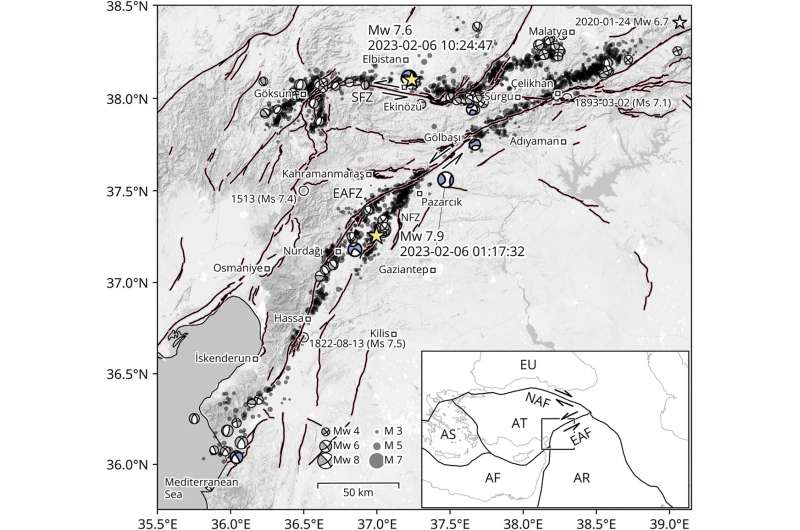This article has been reviewed according to Science X's editorial process and policies. Editors have highlighted the following attributes while ensuring the content's credibility:
fact-checked
peer-reviewed publication
trusted source
proofread
Seismological analysis of the two earthquakes that devastated southern Turkey

On February 6, 2023, two major earthquakes with moment magnitudes of 7.9 and 7.6 occurred in southeastern Türkiye, near the Syria-Türkiye border. The two major earthquakes were close in time and space and can be considered twins. The shaking from the earthquakes caused significant damage to buildings, roads, and people.
The source areas of the two earthquakes are where the Anatolian, Arabian, and African plates meet, developing a network of faults with bends, steps, and branches. However, how these fault networks promote and halt rupture growth in actual earthquakes has been elucidated.
A new study published in Geophysical Research Letters analyzed the source processes of the 2023 Türkiye-Syria twin earthquakes and revealed a hierarchical rupture growth through a complex network of faults. Particularly, researchers found that the first earthquake rupture apparently propagated backward, changing the rupture direction like a boomerang as the rupture grew from a minor fault, which branched sharply from the main fault to a larger-scale rupture at the main fault.
In both the earthquakes, the rupture growth was partially at supershear speed. In the second earthquake, fault bending promoted fast rupture growth but abruptly stopped the rupture.
This study revealed that a geometrically complex fault network controlled the earthquake size and rupture propagation speed and direction, leading to multiscale rupture growth from small- to large-scale rupture episodes.
The new findings of the 2023 earthquake doublet display the irregular rupture evolution and diverse triggering behaviors in a single event and across the earthquake sequence, providing critical inputs in understanding earthquake-rupture dynamics and for better assessing future earthquakes.
More information: Ryo Okuwaki et al, Multi‐Scale Rupture Growth With Alternating Directions in a Complex Fault Network During the 2023 South‐Eastern Türkiye and Syria Earthquake Doublet, Geophysical Research Letters (2023). DOI: 10.1029/2023GL103480
Journal information: Geophysical Research Letters
Provided by University of Tsukuba





















